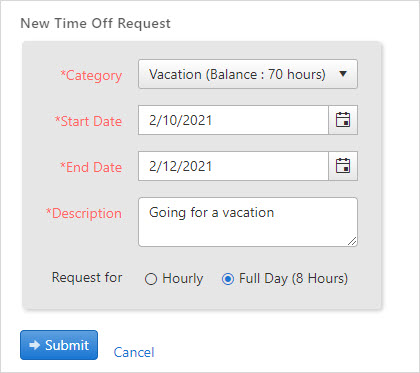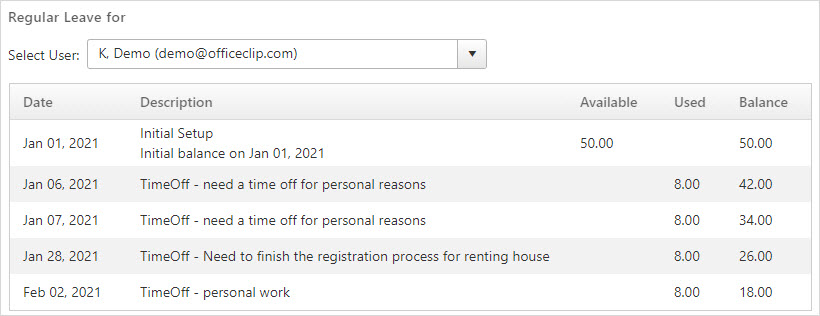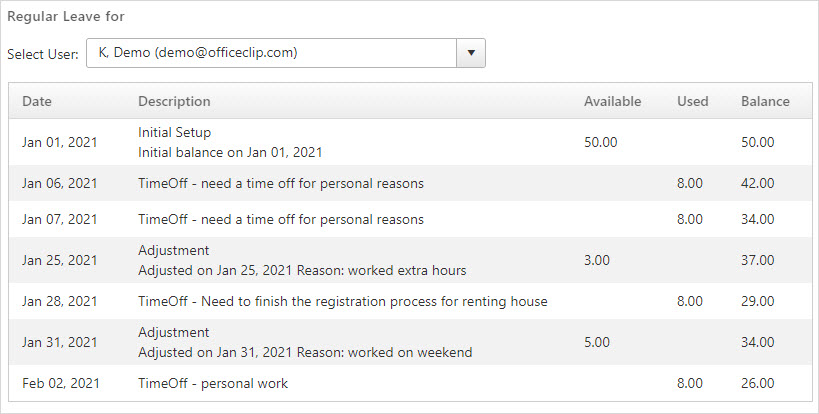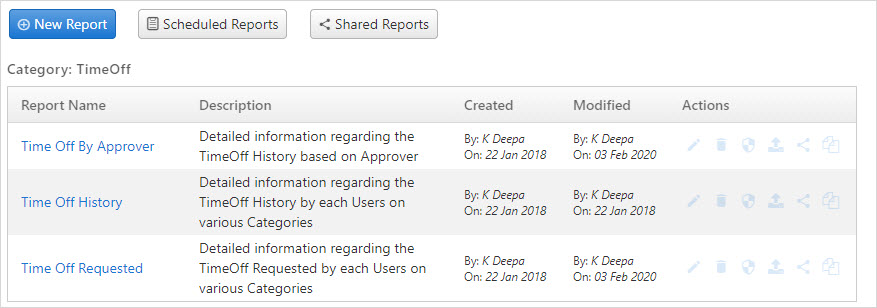This article addresses why employees should be given paid time off for personal purposes and how tracking those is essential. But, unfortunately many businesses end up losing money as they don’t track and calculate the time off’s accurately.
In many countries (like the United States), the government has no mandate to give Paid Time Off (PTO) to the employees. Yet, most companies have created plans to provide these benefits to their employees.
Let us see how tracking time-off with the OfficeClip time-off software application will simplify your work process.
What is Paid Time Off(PTO)?
PTO(Paid Time Off) is an organizational policy that provides the employees with bankable hours, where employees get paid while taking leave from work.
These leaves consist of sick leaves, vacation days, leaves for medical emergencies or personal reasons. All these leaves are a PTO package, and the employee can use these at their discretion.
Every company has different policies for Paid Time Off. For example, some companies provide an increased number of Time offs with increasing years of service, while some provide long-term leaves as a sabbatical.
Good time off policies helps to retain old employees and attract the best candidates during recruitment.
Many organization even allows the flexibility of sharing Paid Time Offs between departmental employees.
Why is Paid Time Off important?

- Paid time off gives employees required rest from the monotony of work.
- Most managers agree that encouraging time off makes their employees more willing to work long hours when needed. This, in turn, will help increase productivity.
- It helps balance work and personal life, which will help them take care of other projects and pursue other activities.
- According to Harvard Business Review, 1 in 5 highly engaged employees experience high levels of burnout and stress leading to fatigue, disengagement, and low performance. This is a direct result of not taking appropriate time off from work.
Different ways of Tracking Time Off’s:
- Email: Previously, many people would email requesting a time off to their managers/supervisors. But it would be difficult to track the number of leaves for a whole year in a large organization. The payroll calculations would become a tedious process.
- Spreadsheets: Today, few businesses also use spreadsheets to track time off. But with data scattered in many spreadsheets, again manual calculations process becomes strenuous. There are also chances of data getting misplaced or lost.
- Software: Using software to track employee’s time off is the most desirable option. It allows the creation of proper leave categories, accrual policies, adding adjustments, and viewing time off history. It smoothens the time off approval process and the payroll calculation process.
Advantages of Paid Time Off (PTO):
For Employers:
- A good PTO policy can serve as an incentive to attract prospective employees while retaining current employees.
- The Paid Time Off policy provides more benefits to senior employees. Companies want to retain them and offer more benefits in increasing their Paid Time Offs.
- It becomes easy for the HR department to track the kinds of leaves employees take and make payroll calculations easier.
- In the absence of a senior employee, a junior employee gets a chance to handle new responsibilities and gain experience. This will help to transfer knowledge and vital information between the team members.
For Employees:
- With flexible time offs available, employees can use them whenever they like and for whatever reason they want.
- It will help create a work-life balance for employees and focus more on their family, personal growth, and other individual activities. This, in turn, will help to reduce stress and allow them to concentrate on required tasks at home and improve productivity at work.
- With different PTO categories available, the employee no longer has to make excuses to use a sick day. It will help to create transparency between the employee and employer.
- Employees who have a bank of Paid Time Off hours feel more empowered because they do not have to justify their day-offs and can take time offs as and when they need.
Disadvantages of PTO:
Employers
- When an employee takes time off, some other person may need to cover her responsibilities; for a smaller organization with fewer employees, it may be a difficult task.
- PTOs are expensive, employees are receiving payments for not doing any work. If someone is takes time off for a week, they get the payment for the whole week. Not every employer, especially small businesses, cannot afford this cost.
- It is crucial to plan the PTOs during popular times. Many employees may consider taking an extended vacation during the Christmas season or the new year. So, managers need to discuss these issues among the staff members and plan time offs accordingly.
- Depending on the company’s PTO policy, some employees may leave or quit with a large bank of PTO day leaves, which may add some additional financial burden on the company.
Employees
- Sometimes employees may report to work sick to save their time off for an extended vacation.
- Few less cautious employees may see that they have 20 days PTO and may plan a vacation of 20 days, leaving no room for medical emergencies or sick leaves.
Things to consider before tracking Time Offs:
-
While creating Leave categories:
- Kinds of leave categories to create
- Whether to enable or disable accrual policies for specific categories
- Should the time off be visible in the Timesheet while tracking work hours?
- Should weekends be normal time-offs, if time-off is requested between weekends?
-
While creating Accrual policies for each leave category:
- What should be the accrual period, daily, weekly, monthly, or yearly?
- Fix the number of accruals for every employee based on their years of service in the organization.
- Should accruals be prorated if an employee leaves the company or is terminated in the middle of the year?
- What should be the calculation period in the beginning of the year, end of the year, or employee anniversary date?
- What should be the maximum accrual limit for each accrual policy
- Encash accruals or set the carry-over limit for next year
Implementation of Paid Time Off in OfficeClip
Along with tracking time in OfficeClip, your team can also track their Time Offs. Tracking time off and tracking time for your employees within one application will help to maintain all the data in one place.
Step 1: Creating categories for Time Off:
Administrators need to create categories of Time Offs in the system.

These leave categories consist of name, code, and description. Enabling accruals will help to create different policies for each leave category.
In addition, these leave categories will help determine who is taking leave and for what purpose through the history in each category. The employees can also view the availability of their time offs in each category and plan leaves accordingly.
Step 2: Create Accrual Policies for various Time Off categories:
Accruals are the amount of Time off’s employees earn as per the company’s policy, which has not been used or paid. The fixed number of hours accrued every month in the employee’s leave account is calculated and are redeemed based on the company policy. Many companies limit how much accrued Time offs to roll over or how many Time offs can be compensated.
For example, John has Paid Time Off 1.5 days every month starting January. So, in February end, John would have accrued three days of paid Time offs. Some companies allow cash out of the balance of paid leaves at the end of the year, while others allow it to carry over to the next year (up to a maximum).
The administrators create these policies. Accrual policy in each leave category varies from person to person in an organization. It usually depends on the rank of the employee or years of service.

After creation of accrual policies, the Administrators set up the users for these accruals and the effective date. When the employee puts the time off request, the system automatically calculates the time off hours.
The user will receive a warning, if the time offs for a particular category are used up. The employees can also check their time off balances from the History or My Time offs.
Step 3: Creating a Time Off request
Employees create the Time Off requests and the supervisors approve them. Employees can request their time off as shown below. They can either request a full-time off or a partial day time off.

Step 4: Approving the Time Off request:
Every time off request needs an approval. The Administrator sets an approver for each user. The approver can approve or reject the time offs and add a comment for the rejected time-offs.

Step 5: Checking PTO balance:
Employees, supervisors, and administrators can easily view the PTO balance. In addition, it shows a balance sheet of all the Time Offs requested and approved for the entire year.

Step 6: Making Adjustments:
OfficeClip Time off application can make adjustments for time worked. For example, the employees often work during weekends or work extra time after the usual office hours. These working hours during the weekends or overtime are Adjustments against time offs.

Configure the Adjustments with the adjustment date, hours worked, and description. The work hours will be adjusted in that particular leave category.
Step 7: Monitoring employee availability with Time Off Calendar & Reports:
OfficeClip offers a calendar to view the time off statuses for the entire team. As a result, it gives a better idea of employee availability and helps better plan and allocate work.

Similarly, Time off reports also give an idea of the Time off requested, Time off history, and Time off by Approver. In addition, Administrators can also create custom reports for Time off based on their requirements.

Conclusion:
Using OfficeClip Free Time off tracker will:
- Make it easy to track leaves taken by employees in different categories.
- Streamline the time off request process and approvals.
- It will give a clear idea of employees’ time off, available balance, used balance, and availability.
- The payroll calculations become much easier with various time off categories and different accrual policies in each category.
- Paid time off gives some control over the unscheduled absence.
Deepa Kapoor is an online writer for small businesses. She loves to write on the advancements of new technologies and how it affects our lives. She always explores ways to make small businesses more profitable. When not writing, she enjoys reading books and cooking exotic traditional food.

